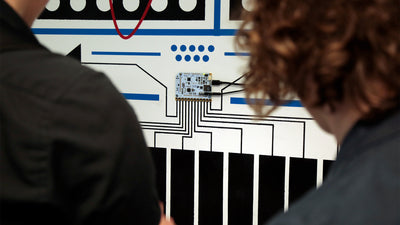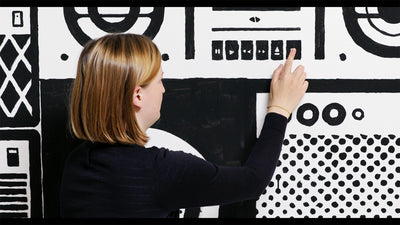Origami Meditation Mural - An Interactive Paper Origami Installation

Using the power of the Pi Cap with the fascinating art of origami to create a unique installation
Origami Artist, Ross Symons is the person behind the amazing Instagram account White on Rice, where he shares his mini paper origami creations and models, but he’s also creating origami installations. The installation we’re going to talk about isn’t one of his traditional origami projects, but it will definitely blow your mind.
Ross shares wanted to use the Pi Cap board with a Raspberry Pi for an installation for some time but he hadn’t found the opportunity. When the organisers of South Africa’s first Visual Merchandising Festival approached him to design something, he thought this would be the perfect opportunity.
He wanted to create an installation that could allow people to interact with origami, which is not something that you often do, and use sound as the response mechanism.
The basic idea was to make something that would make people feel a little relaxed after using it. So Ross created “Wonder Wall – an Origami Meditation Mural”, which invited people to pick up the headphones alongside the wall and listen to the tranquil sounds that the paper origami flowers made when they were touched.
Initially, he was going to use a big wooden board to attach everything to but he decided to use a 1x1m artist canvas instead. This was super light to move around. It allowed him to paint the conductive paint easily onto the surface and the installation didn’t need 4 men and a truck to transport it. The canvas also allowed him to easily press drawing pins through the front where the interactive points needed to be. Drawing pins are easier to remove than nails from wood.
The next step was folding the paper origami in flowers shape. The flowers/tiles were folded from 25x25cm square sheets. He only had 12 inputs to work with on the board so he scattered 12 green flowers around the canvas where the rest were folded in white. The green flowers became the interaction points. He had to make sure that the canvas had a gap behind it so the wires for the headphones and the board/s had enough space to hang behind the installation. 4 L brackets were used to mount the canvas onto the wall.
Attaching the Pi Cap to a Raspberry Pi allows for some seriously awesome and creative executions. Ross used this combo to allow the sounds to fade subtly in and out of each other as they were touched. This project was meant to create a sense of calm relaxation, so switching abruptly from sound to sound would have taken away from the effect he was trying to achieve. He managed to do this with some Python code on the Raspberry Pi – PyGame was the library he used for the sound manipulation.

Once he had all the flowers in place and a drawing pin (for conductivity) pressed through each one, he had to connect them all at the back of the canvas. He also used conductive paint to paint lines from each node on the Pi Cap, but he decided to use materials such as copper tape to connect the pins to the nodes. This also ended up looking pretty cool with straight copper lines shooting out from the board.
Once the boards were attached to each other, he mounted them onto a piece of white foam board. He needed to do this so the board was not sitting at an angle on the canvas. When the boards are connected, the Raspberry Pi’s USB ports stick out slightly above the Pi Cap so he used this easy method to fix it.
He also used Electric Paint to cold solder the Pi Cap nodes to the foam board and also to connect some of the copper lines that ran to the pins. The copper tape could only run along straight lines so in order to extend the tape he had to use two or three strips connected with a squeeze of paint to connect them.
However, there were a few challenges, they were all fixable and the tech worked solidly. The response he received from people who interacted with the installation was very positive.
Images & Video: Ross Symons
We love it when you share your projects! Post your project on Instagram, YouTube, or Twitter, and make sure to tag @bareconductive or use #bareconductive. You can also send your videos and photos to info@bareconductive.com so we can post them on our site for the world to see.







